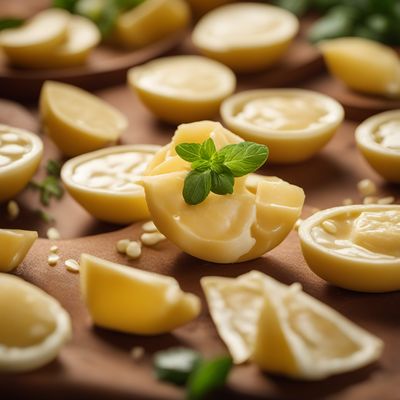
Ingredient
Cheese, telemea
The Creamy Delight: Exploring the Richness of Telemea Cheese
Telemea cheese is a semi-soft, crumbly cheese with a creamy texture and a slightly tangy taste. It is made from sheep's milk or a combination of sheep's and cow's milk. The cheese has a pale yellow color and is often shaped into small rounds or blocks. Its crumbly texture makes it easy to crumble or grate, making it a popular choice for salads, spreads, and baked dishes. The cheese has a distinct aroma that intensifies as it ages, adding depth to its flavor.
Origins and history
Telemea cheese has its origins in Romania and is deeply rooted in the country's culinary heritage. It has been produced for centuries, with historical records dating back to the 14th century. Traditionally, telemea cheese was made by shepherds in the Carpathian Mountains using sheep's milk. Over time, the production of telemea cheese expanded to other regions in Eastern Europe, including Moldova and Bulgaria. Today, it is enjoyed not only in its country of origin but also in various international cuisines.
Nutritional information
Telemea cheese is a good source of protein, calcium, and phosphorus. It is also rich in vitamins A and B12. A 1-ounce (28g) serving of telemea cheese contains approximately 80 calories.
Allergens
Telemea cheese may contain lactose and is not suitable for individuals with lactose intolerance or dairy allergies.
How to select
When selecting telemea cheese, look for a cheese that is firm but not overly dry. It should have a fresh aroma and a slightly tangy taste. Avoid cheeses with any signs of mold or discoloration.
Storage recommendations
To maintain the freshness and quality of telemea cheese, it should be stored in the refrigerator in an airtight container or wrapped tightly in plastic wrap. It is best consumed within a week of purchase.
How to produce
Telemea cheese can be produced at home by combining sheep's milk or a combination of sheep's and cow's milk with rennet or lemon juice to curdle the milk. The curds are then drained, pressed, and aged for a period of time to develop the desired flavor and texture.
Preparation tips
Telemea cheese can be enjoyed in various ways. It can be crumbled over salads, melted into omelets or pasta dishes, or used as a filling for pastries. It pairs well with fruits, nuts, and honey, making it a versatile ingredient in both savory and sweet recipes. When using telemea cheese in hot dishes, it is recommended to add it towards the end of the cooking process to prevent it from becoming too rubbery.
Substitutions
Feta cheese or queso fresco can be used as substitutes for telemea cheese, as they share similar crumbly textures and tangy flavors.
Culinary uses
Telemea cheese is commonly used in traditional Romanian dishes such as sarmale (stuffed cabbage rolls), mici (grilled minced meat rolls), and plăcinte (savory pastries). It is also a popular choice for cheese spreads, sandwiches, and pizza toppings. Additionally, telemea cheese can be enjoyed on its own or paired with fruits and nuts as part of a cheese platter.
Availability
Telemea cheese is commonly available in Romania, Moldova, and Bulgaria. It can also be found in specialty stores or international markets in other countries.



